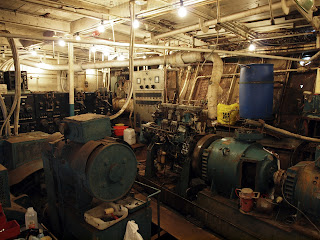Today the Baragoola welcomes you with hints of her former glory. The name is clearly visible despite loosing several of the bolted letters.
The road ahead may be a stormy one but the Baragoola has weathered almost a century of the vicissitudes of nature, man's fickleness and the march of time. The Baragoola belonged to a class of almost identical single funnelled, double ended ferries that included the Bingarra, Burra Bra and Balgowlah, all of which have either been scuttled or scrapped.
The Baragoola operated as a ferry from 1922 until 1983 after which she was retired. For 2 years there were efforts to use her as a floating university but this never came to pass and she was sold to private ownership. For the past 25 years efforts to preserve her have met with mixed success and today the Baragoola is located at Balls Head next to historic coal storage silos (the sandstone structures to the right in the above photo) and just behind the former lighthouse tender Cape Don (subject of a feature coming soon).
A tour of the Baragoola from the Bridge to the Engine Room:
The remains of the forward wheelhouse. The Baragoola being a double ended ferry had duplicate wheelhouses at both ends of the top deck and unfortunately both were vandalised in the decades spent laid up. The grey-blue machine in the centre of the photo is the telemotor on which hung the ship's wheel. Out of shot to the right was a wall and door to the Captain's cabin.
The controls for the Chadburn engine telegraph robbed of its distinctive covering and familiar shape.
The top deck of the Baragoola is covered with boards and tarpaulins to protect the interior form leaking rainwater. This area was further damaged when the military staged an airborne exercise and the down draft from the helicopters rotors flattened railings and tore away coverings.
The foredeck of the Baragoola with original winch and ventilator. Apart from a new, shorter funnel in 1958, the superstructure of the Baragoola is practically unchanged from her original appearance.
The upper deck has been cleaned and shows that the structure of the ship is sound and stable. The teak decking and benches however still need some attention....
Some leg rests and wooden bits awaiting to be rejoined to their companions.
A solitary screw awaits to be rejoined with its parent.
The grand staircase which leads down to the lower deck has lost none of its Edwardian elegance. There is another staircase at the other end of the deck.
An alarm box which was rarely used during operation now awaits a well needed clean. The amount of grime that has accumulated over the past two decades can be gauged by the small clean spot on the lower left.
Gear boxes and a working pump in one corner of the machinery spaces. The pump worked after some cleaning and greasing.
A corner of engine room with the hull to the left and a corner of the Gardner diesel to the right.
Close up of the Gardner diesels which are still operational despite 25 years of inactivity.
The Generator Room sits just behind the main engine room.
Corner of generator room with switchboards.
The still working bilge pump and the watertight door which leads into the engine room.
Switches from the control panel in the Generator Room.
A restored bulkhead with newly applied rust protective paint and in the far right corner an the original Esso oil tank. In return for using Esso oil, there were Esso advertisements posted on bulkheads throughout the ferry.
The walkways have been deemed unsafe to use and the only way to reach the Baragoola is to take a dinghy out and moor next to the ferry.
Additional information for this articles was sourced from:
Mead, Tom Manly Ferries of Sydney Harbour, Child & Associates Publishing, Sydney, 1994, p172-173.
To learn more about how you can help keep the Baragoola afloat for future generations see: http://www.savethebaragoola.com/




















